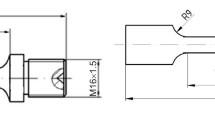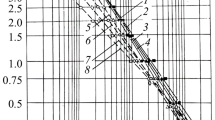Abstract
Results of comparative tests for tensile strength and low-cycle fatigue of specimens of high-temperature nickel alloys ÉI929 and TsNK-7 without a coat and with a diffusion aluminide coat (Al−Si−REM) are presented. Fracture surfaces of the specimens are studied by the electron-microscopic method. It is shown that at a test temperature of 900°C the coat is plastic and is preserved without signs of damage on the whole of the surface of the specimen virtually without affecting the short-term strength and the fatigue resistance of the alloys.
Similar content being viewed by others
References
V. I. Nikitin, “Use of coats for protecting blades of gas turbines from sulfide-oxide corrosion: A review,”Energomashinostroenie, No. 2, 41–44 (1980).
P. T. Kolomytsev,Gas Corrosion and Strength of Nickel Alloys [in Russian], Metallurgiya, Moscow (1984).
S. V. Kositsyn, N. B. Vandysheva, B. N. Guzanov, et al., “Effect of the composition and structure of high-strength nickel alloys on the structure and properties of diffusion coats,” in:Protective Coats on Metals [in Russian], Issue 21, Naukova Dumka, Kiev (1987), pp. 20–24.
V. P. Lesnikov, V. V. Gribov, E. G. Lesnikova, et al., “Effect of the structure of protective coats in the Al−Si system on the fatigue resistance of alloy EP539 LM,” in:Protective Coats on Metals, Issue 21 [in Russian], Naukova Dumka, Kiev (1987). pp. 84–87.
B. N. Guzanov, V. G. Sorokin, and S. V. Kositsyn, “Effect of protective coats on the mechanical properties of high-temperture alloys,”Probl. Prochn., No. 1, 100–103 (1984).
Yu. G. Veksler, V. V. Gribov, V. P. Lesnikov, et al., “Effect of protective coats on the high-temperature strength of heat resistant alloys,”Probl. Prochn., No. 8, 76–78 (1986).
L. M. Akimov,Endurance of Heat-Resistant Materials [in Russian], Metallurgiya, Moscow (1977).
B. N. Guzanov, S. V. Kositsyn, V. G. Sorokin, et al., “Effect of thermodiffusion coats of the aluminide class on the corrosion resistance of high-temperature nickel alloys,”Energomashinostroenie, No. 1, 24–26 (1984).
B. N. Guzanov, V. P. Kuznetsov, S. N. Kositsyn, et al., “On the effect of silicon on the protective properties of aluminide coats,”Zashchita Met.,18(1), 157–159 (1982).
B. N. Guzanov, N. B. Vandysheva, S. V. Kositsyn, et al., “Substantiation of the temperature regime of the deposition of a protective coat onto a high-chromium nickel alloy,” in:New Materials and Special Production Processes. Sh. Nauch. Trudov TsNIITMASh, No. 226 [in Russian], Moscow (1991). pp. 52–57.
Author information
Authors and Affiliations
Additional information
Translated from Metallovedenie i Termicheskaya Obrabotka Metallov, No. 3, pp. 25–28, March, 1999.
Rights and permissions
About this article
Cite this article
Pugacheva, N.B., Kositsyn, S.V. Special features of fracture of nickel alloys with a diffusion aluminide coat in tensile and low-cycle fatigue tests. Met Sci Heat Treat 41, 117–120 (1999). https://doi.org/10.1007/BF02467696
Issue Date:
DOI: https://doi.org/10.1007/BF02467696




